外研版(2019)必修第一册Unit 2 Exploring English Starting out & Understanding ideas 课件-(33张ppt)
文档属性
| 名称 | 外研版(2019)必修第一册Unit 2 Exploring English Starting out & Understanding ideas 课件-(33张ppt) |  | |
| 格式 | zip | ||
| 文件大小 | 30.0MB | ||
| 资源类型 | 教案 | ||
| 版本资源 | 外研版(2019) | ||
| 科目 | 英语 | ||
| 更新时间 | 2022-11-07 18:58:40 | ||
图片预览

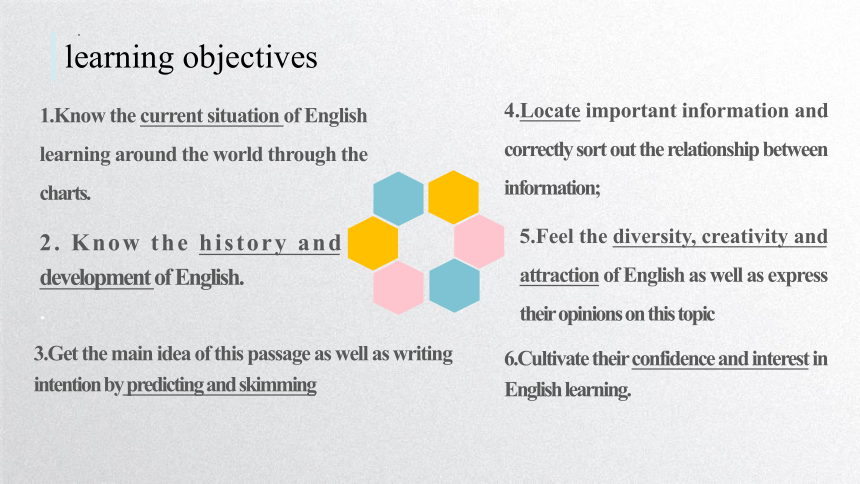


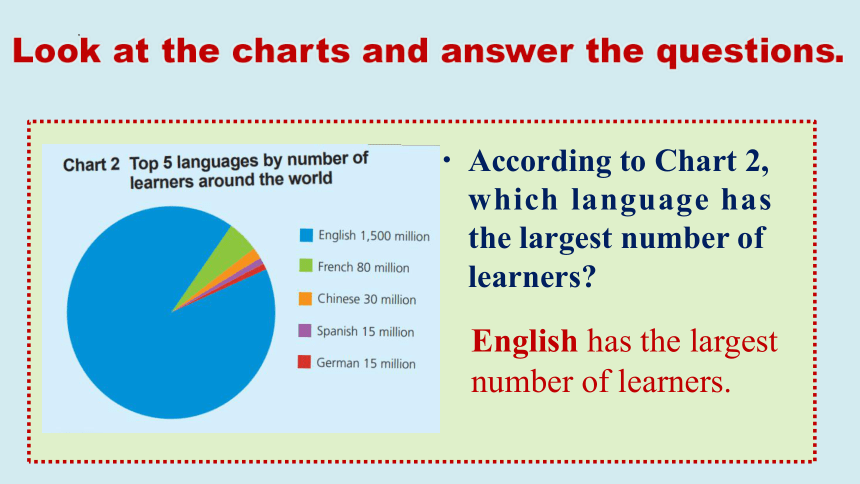
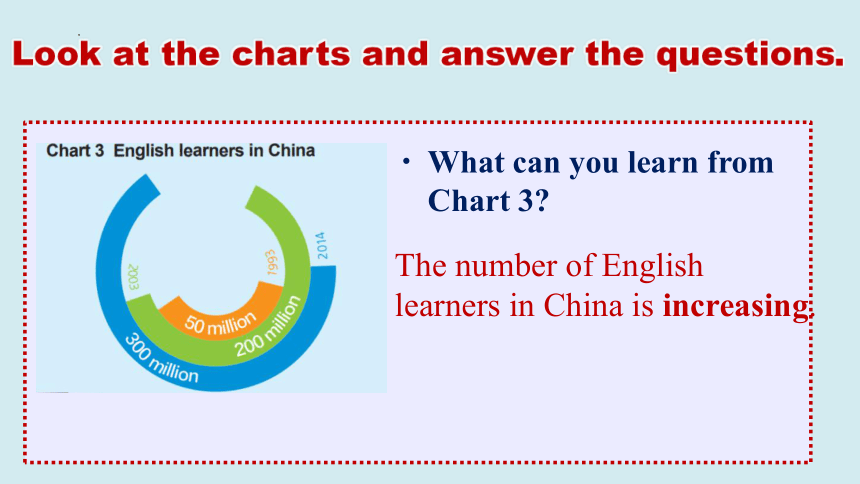
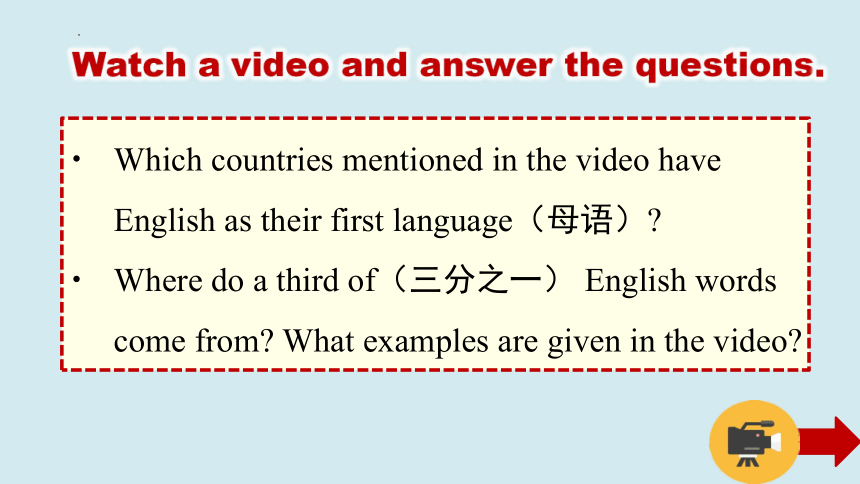


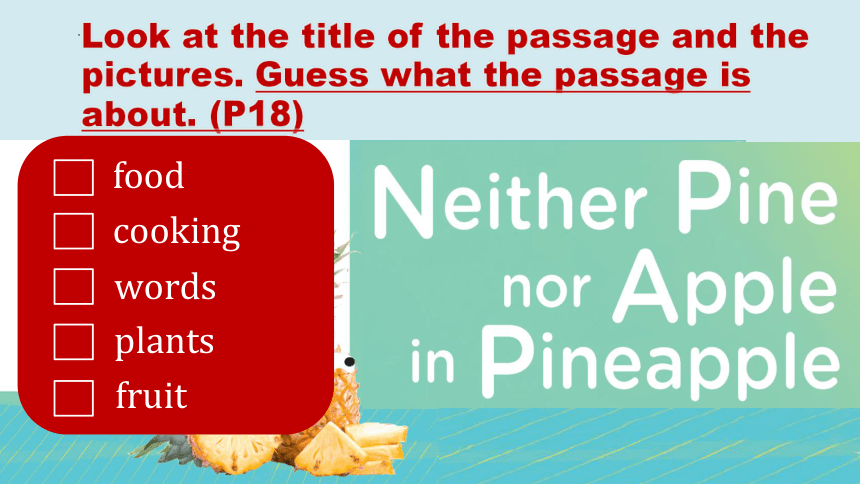

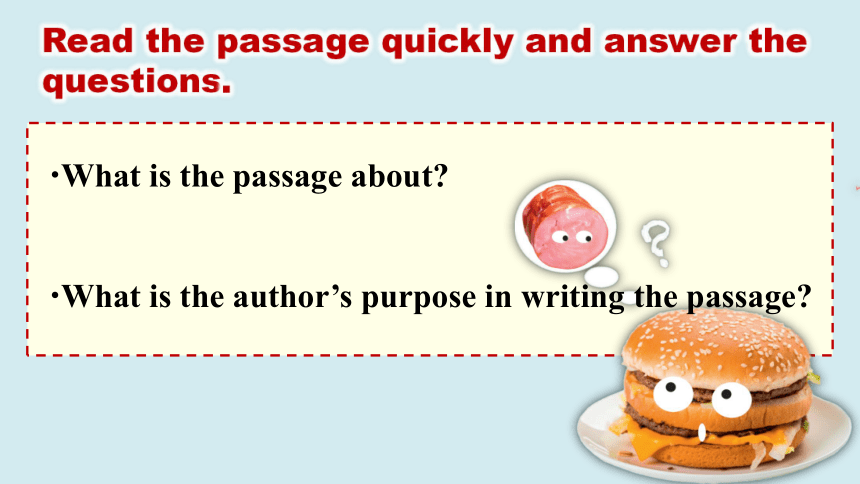
文档简介
(共33张PPT)
Unit 2
Neither Pine nor Apple in Pineapple
learning objectives
1.Know the current situation of English learning around the world through the charts.
2. Know the history and development of English.
.
3.Get the main idea of this passage as well as writing intention by predicting and skimming
4.Locate important information and correctly sort out the relationship between information;
5.Feel the diversity, creativity and attraction of English as well as express their opinions on this topic
6.Cultivate their confidence and interest in English learning.
Ⅰ
Pre-reading
Look at the charts and answer the questions.
According to Chart 1, which language has the largest number of native speakers
Chinese has the largest number of native speakers.
Look at the charts and answer the questions.
According to Chart 2, which language has the largest number of learners
English has the largest number of learners.
Look at the charts and answer the questions.
What can you learn from Chart 3
The number of English learners in China is increasing.
Watch a video and answer the questions.
Which countries mentioned in the video have English as their first language(母语)
Where do a third of(三分之一) English words come from What examples are given in the video
Which countries mentioned in the video have English as their first language
Where do a third of English words come from What examples are given in the video
The UK, Ireland, the USA, Canada, New Zealand and Australia.
More than a third of English words come from French. For example, “fruit”, “table”, “crocodile” and “invasion”.
Look at the title of the passage and the pictures. Guess what the passage is about. (P18)
food
cooking
words
plants
fruit
Ⅱ
Fast reading
Read the passage quickly and answer the questions.
What is the passage about
What is the author’s purpose in writing the passage
Read the passage quickly and answer the questions.
What is the passage about
food
cooking
words
plants
fruit
Read the passage quickly and answer the questions.
What is the author’s purpose in writing the passage
A. To tell us that English is difficult to learn.
B. To give advice on how to learn English.
C. To show that English is interesting and creative.
D. To explain how English was created.
III
Intensive reading
Read the passage carefully and complete the notes with words from the passage. (P21)
240
秒
倒计时还有
In order to support his idea, the author uses many examples that show the 1__________ madness of English. no egg in eggplant no ham in 2.__________ neither pine nor apple in 3. ____________ sculpt a sculpture
paint a(n) 4.__________
BUT take a photo
unique
hamburger
pineapple
painting
We can’t always understand a compound word(复合词) by adding the meanings of the words it is made up of!
seasick → sick at sea 5__________→ sick in the air 6________ → sick in a car BUT 7 ________ → sick at home “Hard” is the opposite of “soft”.
“Hardly”and “softly” are not a(n) 8___________ pair.
airsick
carsick
homesick
opposing
The same rule doesn’t always apply to everything!
同样的规则并不总是适用于所有的情况!
“Harmless” is the opposite of “harmful”. Shameful and shameless 9_________ are the same. burn up → burn down
fill in a form→ 10 _____ a form
behaviors
fill out
Different words or phrases may have the same meaning!
不同的单词或短语可能有相同的意思!
Stars are out. → They are visible. Lights are out. → They are 11 __________. I wind up my watch. →It starts.
I wind up the passage. →
It 12________.
The reason is that English was invented by people, and it 13 __________ the creativity of the human race. invisible
ends
reflects
The same words and phrases may have different meanings in different contexts.
同样的单词和短语可能有在不同的语境中有不同的含义。
Read the following information and answer the questions. (P21)
How did pineapples, hamburgers and eggplants get their names
Eggplants got the name because they used to look
like eggs.
How did pineapples, hamburgers and eggplants get their names
The name of “pineapple” developed from the spanish word “pina”, with “apple” added to show it’s a kind of fruit.
The name of hamburger came from the idea of “Hamburg steak”, and later people reinvented it and called it “hamburger”.
V
Post-reading
Can you find more similar examples in Chinese For example, there isn’t a wife in a “Laopobing”
蚂蚁上树 麻婆豆腐
鱼香肉丝 鸳鸯火锅
佛跳墙 虎皮青椒
夫妻肺片 丝袜奶茶
鱼香肉丝 娃娃菜
............
Think and share
What are the characteristics(特点) of English according to the text
diversity
creativity
complexity
unique
interesting
enjoyable
What is the worst kind of fish
Selfish
What is the longest word in English
Smiles
because there is a "mile" betweenthe first letter "S" and the last letter "s".
Let’s play English!
Why is a river rich
Because it has two banks.
Why did a man throw the butter out the window
He wanted to see the butterfly.
Let’s play English!
IV
summary
1.Know the current situation of English learning around the world through the charts.
2. Know the history and development of English.
.
3.Feel the diversity, creativity and attraction of English as well as express their opinions on this topic
Summary
VI
Homework
Do you have any difficulty 1. (learn)English better Have you ever wondered why there is no ham 2. your hamburger 3.___ why you can’t find any egg in eggplant Maybe this will get you 4._______ (think)how crazy the language of English is. We like to paint a 5.______(paint),and we are traveling in 6.__ car but we take photos and travel on the bus. When we see the rain, we say “it 7. (rain)”but no sunshining to use when seeing sunshine. The words are really 8.__________(confuse).Such unique 9. (mad)can be seen almost everywhere because English 10. (reflect)the creativity of the human race.
Fill in the blanks
learning
in
and
thinking
painting
the
is raining
confusing
madness
reflects
give some Chinese examples that can cause misunderstandings.
(search online)
Unit 2
Neither Pine nor Apple in Pineapple
learning objectives
1.Know the current situation of English learning around the world through the charts.
2. Know the history and development of English.
.
3.Get the main idea of this passage as well as writing intention by predicting and skimming
4.Locate important information and correctly sort out the relationship between information;
5.Feel the diversity, creativity and attraction of English as well as express their opinions on this topic
6.Cultivate their confidence and interest in English learning.
Ⅰ
Pre-reading
Look at the charts and answer the questions.
According to Chart 1, which language has the largest number of native speakers
Chinese has the largest number of native speakers.
Look at the charts and answer the questions.
According to Chart 2, which language has the largest number of learners
English has the largest number of learners.
Look at the charts and answer the questions.
What can you learn from Chart 3
The number of English learners in China is increasing.
Watch a video and answer the questions.
Which countries mentioned in the video have English as their first language(母语)
Where do a third of(三分之一) English words come from What examples are given in the video
Which countries mentioned in the video have English as their first language
Where do a third of English words come from What examples are given in the video
The UK, Ireland, the USA, Canada, New Zealand and Australia.
More than a third of English words come from French. For example, “fruit”, “table”, “crocodile” and “invasion”.
Look at the title of the passage and the pictures. Guess what the passage is about. (P18)
food
cooking
words
plants
fruit
Ⅱ
Fast reading
Read the passage quickly and answer the questions.
What is the passage about
What is the author’s purpose in writing the passage
Read the passage quickly and answer the questions.
What is the passage about
food
cooking
words
plants
fruit
Read the passage quickly and answer the questions.
What is the author’s purpose in writing the passage
A. To tell us that English is difficult to learn.
B. To give advice on how to learn English.
C. To show that English is interesting and creative.
D. To explain how English was created.
III
Intensive reading
Read the passage carefully and complete the notes with words from the passage. (P21)
240
秒
倒计时还有
In order to support his idea, the author uses many examples that show the 1__________ madness of English. no egg in eggplant no ham in 2.__________ neither pine nor apple in 3. ____________ sculpt a sculpture
paint a(n) 4.__________
BUT take a photo
unique
hamburger
pineapple
painting
We can’t always understand a compound word(复合词) by adding the meanings of the words it is made up of!
seasick → sick at sea 5__________→ sick in the air 6________ → sick in a car BUT 7 ________ → sick at home “Hard” is the opposite of “soft”.
“Hardly”and “softly” are not a(n) 8___________ pair.
airsick
carsick
homesick
opposing
The same rule doesn’t always apply to everything!
同样的规则并不总是适用于所有的情况!
“Harmless” is the opposite of “harmful”. Shameful and shameless 9_________ are the same. burn up → burn down
fill in a form→ 10 _____ a form
behaviors
fill out
Different words or phrases may have the same meaning!
不同的单词或短语可能有相同的意思!
Stars are out. → They are visible. Lights are out. → They are 11 __________. I wind up my watch. →It starts.
I wind up the passage. →
It 12________.
The reason is that English was invented by people, and it 13 __________ the creativity of the human race. invisible
ends
reflects
The same words and phrases may have different meanings in different contexts.
同样的单词和短语可能有在不同的语境中有不同的含义。
Read the following information and answer the questions. (P21)
How did pineapples, hamburgers and eggplants get their names
Eggplants got the name because they used to look
like eggs.
How did pineapples, hamburgers and eggplants get their names
The name of “pineapple” developed from the spanish word “pina”, with “apple” added to show it’s a kind of fruit.
The name of hamburger came from the idea of “Hamburg steak”, and later people reinvented it and called it “hamburger”.
V
Post-reading
Can you find more similar examples in Chinese For example, there isn’t a wife in a “Laopobing”
蚂蚁上树 麻婆豆腐
鱼香肉丝 鸳鸯火锅
佛跳墙 虎皮青椒
夫妻肺片 丝袜奶茶
鱼香肉丝 娃娃菜
............
Think and share
What are the characteristics(特点) of English according to the text
diversity
creativity
complexity
unique
interesting
enjoyable
What is the worst kind of fish
Selfish
What is the longest word in English
Smiles
because there is a "mile" betweenthe first letter "S" and the last letter "s".
Let’s play English!
Why is a river rich
Because it has two banks.
Why did a man throw the butter out the window
He wanted to see the butterfly.
Let’s play English!
IV
summary
1.Know the current situation of English learning around the world through the charts.
2. Know the history and development of English.
.
3.Feel the diversity, creativity and attraction of English as well as express their opinions on this topic
Summary
VI
Homework
Do you have any difficulty 1. (learn)English better Have you ever wondered why there is no ham 2. your hamburger 3.___ why you can’t find any egg in eggplant Maybe this will get you 4._______ (think)how crazy the language of English is. We like to paint a 5.______(paint),and we are traveling in 6.__ car but we take photos and travel on the bus. When we see the rain, we say “it 7. (rain)”but no sunshining to use when seeing sunshine. The words are really 8.__________(confuse).Such unique 9. (mad)can be seen almost everywhere because English 10. (reflect)the creativity of the human race.
Fill in the blanks
learning
in
and
thinking
painting
the
is raining
confusing
madness
reflects
give some Chinese examples that can cause misunderstandings.
(search online)
